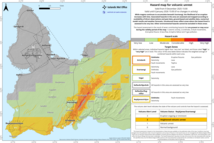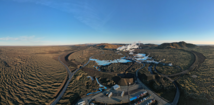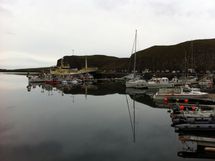Warning
Variable wind 3-10 m/s and widely fair, but isolated showers of snow or sleet near the coast. Frost 0 to 7 deg. C. Increasing easterly wind in the south and west by evening and becoming warmer.
East 13-20 m/s tomorrow morning and intermittent rain, sleet or snow, but slower wind in the east parts. Decreasing wind throughout the day, 8-15 m/s by afternoon, but gale with snow in the northwest. Temperature widely 0 to 7 deg. C, mildest in the far south. Valid to 19.12.2025 00:00 More- Yellow alert for weather: Westfjords More
Home-page - Icelandic Meteorological Office
Weather forecast
Weather forecast for the next 24 hours
Northeast and east 5-13 m/s tomorrow and showers of rain or snow, but 10-18 and intermittent sleet or snow in the northwest until after noon. Decreasing precipitation later in the day. Temperatures between 0 and 7 degrees C in most places, mildest in the far south, but frost inland in the North.
Northeasterly or variable winds 5-13 m/s and intermittent rain or showers tomorrow, but slower in the East. East 13-18, precipitation increasing and becoming warmer in the western part tomorrow evening. Increasing frost in the Northeast.
Forecast made 18.12.2025 05:11
Forecaster's remarks
Snow or sleet with strong winds in the Westfjords until tomorrow morning, see weather warning.
Prepared by the meteorologist on duty 18.12.2025 05:11
If the map and the text forecast differs, then the text forecast applies
Forecast for station - 1
Forecast for station - 2
Forecast for station - 3
Forecast for station - 4
Forecast for station - 5
Maximum wind in Iceland today
| Lowlands | |
|---|---|
| Highlands | |
|---|---|
Maximum and minimum temperature in Iceland today
| Lowlands | |
|---|---|
| Highlands | |
|---|---|
Maximum precipitation in Iceland today
| Lowlands | |
|---|---|
| Highlands | |
|---|---|
Maximum wind in Iceland during the last hour
| Lowlands | |
|---|---|
| Highlands | |
|---|---|
Maximum and minimum temperature in Iceland during the last hour
| Lowlands | |
|---|---|
| Highlands | |
|---|---|
Maximum precipitation in Iceland during the last hour
| Lowlands | |
|---|---|
| Highlands | |
|---|---|
Preliminary results
Earthquakes
Biggest earthquakes during the last 48 hours
| Size | Time | Quality | Location |
|---|---|---|---|
| 2.7 | 17 Dec 15:18:18 | 31.8 | 37.8 km WSW of Hólmavík |
| 2.1 | 17 Dec 07:05:50 | Checked | 9.6 km SW of Kröfluvirkjun |
| 1.9 | 17 Dec 22:53:16 | 79.2 | 24.3 km ESE of Grímsey |
| 1.7 | 18 Dec 02:48:12 | 90.0 | 4.5 km SE of Herðubreið |
| 1.6 | 16 Dec 07:13:01 | Checked | 2.3 km ENE of Hamarinn |
| 1.5 | 17 Dec 22:35:33 | 35.1 | 14.2 km SE of Grímsey |
Week overview -
Earthquake activity throughout the country is described in a weekly summary that is written by a Natural Hazard Specialist. The weekly summary is published on the web every Tuesday. It covers the activity of the previous week in all seismic areas and volcanic systems in the country. If earthquake swarms are ongoing or significant events such as larger earthquakes have occurred during the week, they are specifically discussed. More
Hydrology
Average flow and temperature last 24 hours
| River | Place | Flow | Water temperature |
|---|
Remarks of a specialist
A glacier outburst flood in Skaftá river is receding and the discharge is now around 60 m3/s at Sveinstindur. Conductivity has been decreasing and is now being measured at 370 µS/cm. This suggests that floodwater is still reaching the river. Important to take caution at the river's outlet due to gas pollution.
Due to malfunction we have turned off the service publishing hydrological data on the map. Instead see the data using our Real-time monitoring system.
Written by a specialist at 17 Dec 16:21 GMT
Avalanches
Avalanche bulletins for selected areas
The avalanche bulletin is at a regional scale. It does not necessarily represent avalanche danger in urban areas.
| Region | Tue Dec 16 | Wed Dec 17 | Thu Dec 18 |
|---|---|---|---|
|
Southwest corner
|
|
|
|
|
Northern Westfjords
|
|
|
|
|
Tröllaskagi
|
|
|
|
|
Eyjafjörður (experimental)
|
|
|
|
|
Eastfjords
|
|
|
|
News

Increased Likelihood of an Eruption is ongoing on the Sundhnúkur Crater Row
The rate of magma accumulation beneath Svartsengi has remained fairly stable over the past two weeks. The likelihood of a magma intrusion and an eruption remains elevated in the coming weeks. The hazard assessment remains unchanged until 9 December
Read more
The ninth eruption on the Sundhnúkur crater row has ended
Updated 5 August
The volcanic eruption that began on 16 July on the Sundhnúkur crater row is now officially over, and a new hazard map has been issued. Despite the end of the eruption, life-threatening conditions remain in the area due to unstable lava and the potential for gas pollution. Uplift has resumed, and magma continues to accumulate beneath Svartsengi.
Read moreHeavy thunder and lightning in Northwest Iceland and the Westfjords
By 11:00, more than 450 lightning strikes had been recorded since the activity began.
Read more
Eruption ongoing on the Sundhnúkur crater row
Updated at 11:30, 20 July
The eruption at the Sundhnúkur crater row has caused significant air pollution in recent days, with volcanic haze spreading widely but not fully captured by the national air quality monitoring network. The Icelandic Meteorological Office forecasts gas pollution in South and West Iceland over the coming days, with light winds contributing to persistent haze, especially in the southwest. Vulnerable groups are advised to limit time outdoors if they experience discomfort, and practical guidance for reducing indoor exposure is provided.
Read moreA jökulhlaup from Mýrdalsjökull into the rivers Leirá Syðri and Skálm
The flood is subsiding, and water level and conductivity are now approaching normal values in Skálm.
The flood reached its peak the night before last. IMO´s specialists continue to observe the area
Read moreAnalysis: Climate change made the May heatwave more likely and more intense
In May 2025, an unusually intense heatwave struck Iceland and eastern Greenland, breaking numerous temperature records. On 15 May, Iceland's national May temperature record was set at 26.6°C at Egilsstaðir Airport, with several locations recording temperatures up to 13°C above the monthly average.
A new international analysis by the World Weather Attribution group shows that human-induced climate change made this heatwave around 40 times more likely and, on average, three degrees Celsius hotter than it would have been without global warming. The study also suggests that if global temperatures rise by 2.6°C, such heatwaves could become at least twice as frequent and two degrees hotter.
Read moreShort articles

Past temperature conditions in Iceland
This has been a period of a general rise in temperatures, interrupted by two cold periods. The late 19th century cold period was colder than a corresponding period in mid to late 20th century.
Read moreNew publications and research
- Guðrún Nína Petersen (2025). Alviðruhamrar - Meteorological conditions
- Michelle Parks, Freysteinn Sigmundsson, Vincent Drouin, Ásta R. Hjartardóttir, Halldór Geirsson, Andrew Hooper, Kristín S. Vogfjörð, Benedikt G. Ófeigsson, Sigrún Hreinsdóttir, Esther H. Jensen, Páll Einarsson, Sara Barsotti & Hildur M. Friðriksdóttir. (2023).
- Sahar Rahpeyma, Benedikt Halldórsson, Birgir Hrafnkelsson & Atefe Darzi. (2023). Frequency-dependent site amplification functions for key geological units in Iceland from a Bayesian hierarchical model for earthquake strong-motions.
- Sara Klaasen, Solvi Thrastarson, Yesim Cubuk-Sabuncu, Kristín Jónsdóttir, Lars Gebraad, Patrick Paitz & Andreas Fichtner. Subclacial volvano monitoring with fiber-optic sensing: Grímsvötn, Iceland. (2023).
- Ismael Vera Rodriquez, Marius P. Isken, Torsten Dahm, Oliver D. Lamb, Sin-Mei Wu, Sigríður Kristjánsdóttir, Kristín Jónsdóttir, Pilar Sanchez-Pastor, John Clinton, Christopher Wollin, Alan F. Baird, Andreas Wuestefeld, Beat Booz, Eva P.S.Eibl, Sebastian Heimann, Bettina P. Goertz-Allmann, Philippe Jousset, Volker Qye, Vala Hjörleifsdóttir, Anne Obermann. (2002).
- Lamb, O.D., Gestrich, J.E., Barnie, T.D., Jónsdóttir, K., Ducrocq, C., Shore, M.J., Lees, J.M., Lee, S.J (2022). Acoustic observations of lava fountain activity during the 2021 Fagradalsfjall eruption, Iceland. Bull Volcanol 84, 96. doi.org/10.1007/s00445-022-01602-3
- Freysteinn Sigmundsson, Michelle Parks, Andrew Hooper, Halldór Geirsson, Kristín S. Vogfjörd, Vincent Drouin, Benedikt G. Ófeigsson, Sigrún Hreinsdóttir, Sigurlaug Hjaltadóttir, Kristín Jónsdóttir, Páll Einarsson, Sara Barsotti, Josef Horálek & Thorbjörg Ágústsdóttir (2022). Deformation and seismicity decline before the 2021 Fagradalsfjall eruption. Nature 609, 523–528. doi.org/10.1038/s41586-022-05083-4





